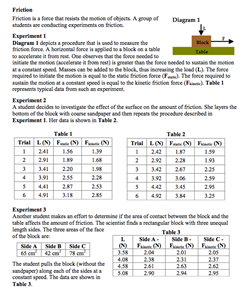 Friction
Friction
Resource:
Science Reasoning Center: Friction
Grade Level: High School
Description:
This passage describes a complex set of three experiments exploring the effect of several variables upon the amount of friction experienced by a wooden block dragged across a surface. Data is presented in the form of three different data tables. Questions target a student's ability to understand the experimental design, to recognize the effect of one variable on another, to extrapolate from the provided data in order to predict the result of conducting additional trials, and to represent the data in the form of a graph.
This activity aligns with the three dimensions of the Next Generation Science Standards in the manner described below:
| Force and Motion (HS-PS2.A.1): Newton's 2nd Law accurately predicts changes in the motion of macroscopic objects. |
Although not explicitly stated in this passage, in each of the three experiments outlined students are applying a result of Newton’s 2nd Law. In all trials the ‘applied’ or pulling force is assumed to be equal to the frictional force. This is true in each of the situations described since objects that are moving at a constant speed must have a net force of zero. This result—which comes directly from Newton’s 2nd Law—is what allows the reader to make this assumption. |
| Cause and Effect: Cause and effect relationships can be suggested and predicted for complex natural and human designed systems by examining what is known about smaller scale mechanisms within the system. |
Three cause-effect relationships are explored in this passage. The effect of increasing load on frictional force is investigated in experiment 1. Experiment 2 considers the frictional effect of changing the surfaces that are in contact. Finally, experiment 3 explores a relationship that—interestingly enough—surface area has no effect on frictional force! |
| Planning and Carrying out Investigations: Plan an investigation or test a design individually and collaboratively to produce data to serve as the basis for evidence in building/revising models, supporting explanations for phenomena, or testing solutions to problems. Consider possible confounding variables and ensure variables are controlled. |
Any well designed experiment changes only one variable at a time in order to explore its effect on the responding (dependent) variable. Questions 1, 3 and 5 in this passage address the student’s ability to understand why this is done. As these questions address the purpose of the control, identify the independent and dependent variables, and note which variable was not investigated in these experiments, students are asked to demonstrate their understanding of how a well-designed experiment is carried out. |
| Analyzing and Interpreting Data: Analyze data using computational models in order to make valid and reliable scientific claims. |
Complex data representations are explored by the reader in four data sets. Several questions at the close of this passage ask the student to both properly read these data presentations as well as to make meaning of this data as they explore factors that affect the frictional force on an object. |
| Engage in Argument from Evidence: Make and defend a claim based on evidence about the natural world that reflects scientific knowledge, and student-generated evidence. |
Just as interesting as identifying the factors that affect the frictional force on an object is exploring what factors do not affect the amount of friction. Questions 6, 7 and 10 ask the reader to engage in arguments from the data presented to identify factors that affect (and do not) affect friction. |
Associated Reading from The Physics Classroom
Other Supporting Pages at The Physics Classroom:
- The Curriculum Corner: Balanced vs. Unbalanced Forces; Net Force Help Sheet; Recognizing Forces; Friction
View Infographic.
(Coming Soon)
Search the NGSS Corner
Maybe you're looking for something really specific that pertains to a desired topic and emphasizes one or more of the listed NGSS dimensions. Why not try a search of this section of our website? Simply select from one or more of the pull-down menus and click Search This page will reload and a collection of possibilities will be displayed in this section of the page and sorted by relevancy.